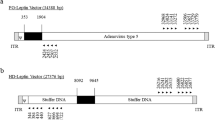Abstract
The bax gene plays a critical role in signaling apoptosis and expression through gene transfer may be valuable in the treatment of a variety of apoptosis-related diseases such as cancer. However, constructing an adenoviral vector expressing a bax gene driven by a constitutive promoter has been difficult, presumably because of the gene's high proapoptotic activity. Here we report a system that induces the expression of the bax gene safely by adenovirus-mediated gene cotransfer. Briefly, the system involves an adenoviral vector containing a human bax cDNA driven by a synthetic promoter consisting of five GAL4-binding sites and a TATA box (GT). This vector expresses a minimal background level of bax protein in cultured mammalian cells thus preventing apoptosis of packaging cells, however, expression of the bax gene can be induced substantially in vitro and in vivo by transferring it into target cells along with an adenoviral vector expressing the transactivator, fusion protein GAL4/VP16. Extensive apoptosis was observed after induction of the bax gene both in cultured human lung carcinoma cells and in the livers of Balb/c mice. Our results suggest that this GAL4 gene regulatory system provides an alternative approach to constructing viral vectors that express potentially toxic genes.
This is a preview of subscription content, access via your institution
Access options
Subscribe to this journal
Receive 12 print issues and online access
$259.00 per year
only $21.58 per issue
Buy this article
- Purchase on Springer Link
- Instant access to full article PDF
Prices may be subject to local taxes which are calculated during checkout




Similar content being viewed by others
References
Kovesdi I et al. Adenoviral vectors for gene transfer Curr Opin Biotech 1997 8: 583–589
Yeh P, Perricaudet M . Advances in adenoviral vectors: from genetic engineering to their biology FASEB J 1997 11: 615–623
Larregina AT et al. FasL induces Fas/Apol-mediated apoptosis in human embryonic kidney 293 cells routinely used to generate E1-deleted adenoviral vectors Gene Therapy 1998 5: 563–568
Arai H, Gordon D, Nabel EG, Nabel GJ . Gene transfer of Fas ligand induces tumor regression in vivo Proc Natl Acad Sci USA 1997 94: 13862–13867
Okuyama T et al. Efficient Fas-ligand gene expression in rodent liver after intravenous injection of a recombinant adenovirus by the use of a Cre-mediated switching system Gene Therapy 1998 5: 1047–1053
Shinoura N et al. Construction, propagation, and titer estimation of recombinant adenoviruses carrying proapoptotic genes Hum Gene Ther 1998 9: 2683–2689
Apte SS, Mattei MG, Olsen BR . Mapping of the human BAX gene to chromosome 19q13.3-q13.4 and isolation of a novel alternatively spliced transcript, BAX delta Genomics 1995 26: 592–594
Oltvai ZN, Milliman CL, Korsmeyer SJ . Bcl-2 heterodimerizes in vivo with a conserved homolog, Bax, that accelerates programmed cell death Cell 1993 74: 609–619
Coll JL et al. Antitumor activity of bax and p53 naked gene transfer in lung cancer: in vitro and in vivo analysis Hum Gene Ther 1998 9: 2063–2074
Fang B, Ji L, Bouvet M, Roth JA . Evaluation of GAL4/TATA in vivo. Induction of transgene expression by adenovirally mediated gene codelivery J Biol Chem 1998 273: 4972–4975
Zhang WW et al. Generation and identification of recombinant adenovirus by liposome-mediated transfection and PCR analysis Biotechniques 1993 15: 868–872
Fueyo J et al. Overexpression of E2F-1 in glioma triggers apoptosis and suppresses tumor growth in vitro and in vivo Nature Med 1998 4: 685–690
Tewari M et al. Yama/CPP32 beta, a mammalian homolog of CED-3, is a CrmA-inhibitable protease that cleaves the death substrate poly (ADP-ribose) polymerase Cell 1995 81: 801–809
Lieber A et al. The role of Kupffer cell activation and viral gene expression in early liver toxicity after infusion of recombinant adenovirus vectors J Virol 1997 71: 8798–8807
Yang Y et al. Cellular immunity to viral antigens limits E1-deleted adenoviruses for gene therapy Proc Natl Acad Sci USA 1994 91: 4407–4411
Acknowledgements
We thank Jude Richard for editorial review and Monica Contreras for assistance in preparing this manuscript. This study was funded by a grant from The University of Texas Physicians Referral Service, an NIH grant for a Specialized Program of Research Excellence (SPORE) in Lung Cancer (P50–CA70907), and an NIH Core Grant for DNA sequencing (CA 16672).
Author information
Authors and Affiliations
Rights and permissions
About this article
Cite this article
Kagawa, S., Pearson, S., Ji, L. et al. A binary adenoviral vector system for expressing high levels of the proapoptotic gene bax. Gene Ther 7, 75–79 (2000). https://doi.org/10.1038/sj.gt.3301048
Received:
Accepted:
Published:
Issue Date:
DOI: https://doi.org/10.1038/sj.gt.3301048
Keywords
This article is cited by
-
BCL-2 family isoforms in apoptosis and cancer
Cell Death & Disease (2019)
-
Telomerase Transcriptional Targeting of Inducible Bax/TRAIL Gene Therapy Improves Gemcitabine Treatment of Pancreatic Cancer
Molecular Therapy (2008)
-
Novel system uses probasin-based promoter, transcriptional silencers and amplification loop to induce high-level prostate expression
BMC Biotechnology (2007)
-
Mitochondrial Medicine: Pharmacological targeting of mitochondria in disease
British Journal of Pharmacology (2007)
-
Voltage-dependent anion channels are dispensable for mitochondrial-dependent cell death
Nature Cell Biology (2007)



